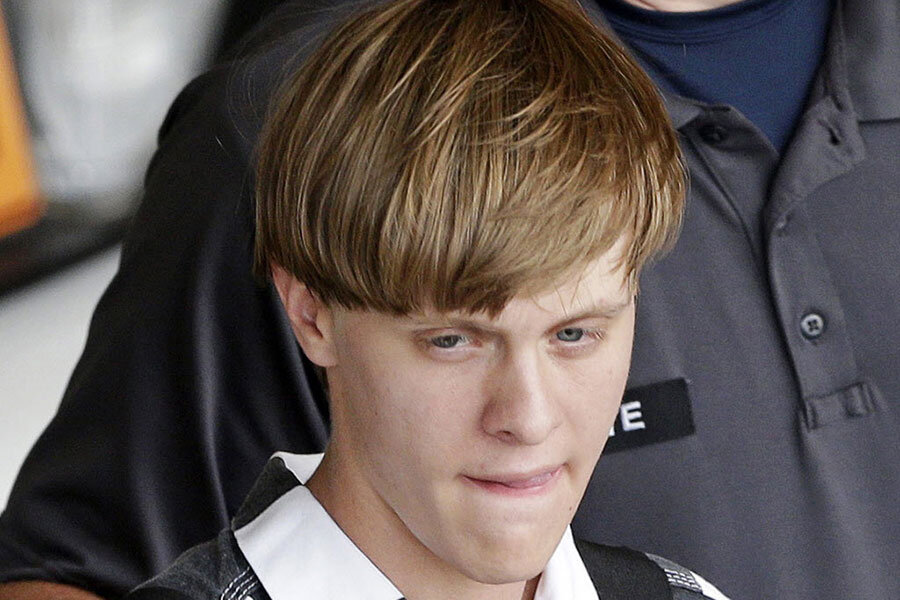Charleston debate: Is domestic or international terrorism the bigger threat?
The Charleston, S.C., church attack is serving to underscore the idea that when it comes to the threat of terrorism on American soil, fear is often in the eye of the beholder.
Loaded with deep emotional currency since 9/11, the word “terrorism” usually evokes images of radical Islam and the billions of dollars spent on massive domestic spying operations and local surveillance of mosques and Muslim businesses by law enforcement agencies like the New York Police Department.
But Charleston has already rekindled debate about what constitutes terrorism, and a new study is pushing the conversation further. It finds that, since 9/11, there have been nearly twice as many people killed in the United States by antigovernment radicals, white supremacists, and other non-Muslim groups than by jihadists – though both numbers are vanishingly small.
In some ways, law enforcement recognizes this. Nearly 3 of 4 law-enforcement agencies said antigovernment extremism was one of the top three terrorist threats in their jurisdiction, compared with only 40 percent that reported Muslim terror as a top risk, according to a survey by Police Executive Research Forum to be released Thursday.
But with the number of antigovernment groups and armed militias in the US rising from 149 in 2008 to 1,360 in 2012, by one count, Charleston is raising questions about whether the fear of Islamist terrorism is disproportionately overshadowing the need to address homegrown extremism.
“In general, it appears to me that we as a country give far more attention to incidents of Muslim extremism than other forms of violent extremism,” says Charles Kurzman, professor of sociology at the University of North Carolina at Chapel Hill and co-director of the Carolina Center for the Study of the Middle East and Muslim Civilizations.
Since the terror attacks in 2001, at least 48 people – including the nine in Charleston – have been killed by domestic extremists, says a study released Wednesday by the Washington-based research center New America.
Dylann Roof, who has admitted to fatally shooting nine members of one of the nation’s most historic black churches last Wednesday, said he wanted to start a “race war.” The young white supremacist also wrote in his manifesto, “I hate the sight of the American flag,” and posted a picture of him burning the nation’s colors.
By contrast, there have been 26 deaths from jihadist attacks during that time, including the 13 fatally shot by Maj. Nidal Hasan in 2009 at Fort Hood in Texas and the four killed by Tamerlan and Dzhokar Tsarnaev during and after the Boston Marathon two years ago.
Such tallies are inherently controversial – and subjective. But another, similar attempt by the journalism watchdog group Politifact on Jan. 8 came to the same conclusion: 39 people killed in the US by right-wing extremists, 26 killed by jihadists.
Regarding the new survey, “We were a bit surprised to see how much more prevalent the threats they reported as being from violent right-wing and antigovernment extremists than from Muslim extremists,” Professor Kurzman says.
He notes that those who express admiration for the Islamic State or make jihadist statements on social media trigger sophisticated federal investigations or undercover operations much more quickly than those who express murderous white supremacist sentiments or anti-government violence.
That, of course, could be a reason why the death toll for jihadist violence could be comparatively lower. Many plots have been uncovered.
But Mr. Roof went unnoticed by authorities.
Since the massacre at the Emanuel African Methodist Episcopal Church in Charleston last week, there has been debate about whether Roof’s racially-motivated murders should be considered an act of domestic terrorism.
Certainly, the actions of Timothy McVeigh, the antigovernment extremist who blew up the federal building in Oklahoma City in 1995, killing 168 people, were considered terrorism.
“If there’s one lesson we seem to have forgotten 20 years after Oklahoma City, it’s that extremist violence comes in all shapes and sizes,” said John Horgan, a terror expert at the University of Massachusetts in Lowell, to The New York Times. “And very often it comes from someplace you’re least suspecting.”
During President Obama’s first term, the number of antigovernment groups and armed militias in the US skyrocketed 813 percent (from 149 to 1,360), according to the Southern Poverty Law Center, which tracks such groups. There are also currently 784 known hate groups, from neo-Nazi skinheads to black separatists.
“There’s an acceptance now of the idea that the threat from jihadi terrorism in the United States has been overblown,” Dr. Horgan also told the Times. “And there’s a belief that the threat of right-wing, antigovernment violence has been underestimated.”







